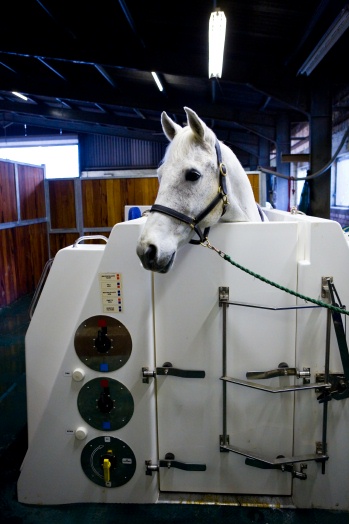You can lead a horse to water…
Monday, December 17th, 2007
Having heard about a hydrotherapy centre for horses in Nottinghamshire, we went along to see what it was all about.

Right in the heart of the Vale of Belvoir, Emma Hawthorne runs Flawborough Equine and Hydrotherapy Centre, which specialises in offering treatments to aid the recovery and rehabilitation of horses. Emma had always worked with horses, ranging from working at the National Stud in France to setting up a livery yard on her husband’s family farm, but it was only when her best and most expensive horse got injured a few years ago that she came across the type of spa treatment that she would eventually start offering herself.

Emma Hawthorne in her kitchen
The horse had a deep digital flexor tendon injury and, having gone down a more traditional route of trying to cure him, she had been told that he was a write-off. Failing to believe that there was nothing that could be done, she did some research and found out about an Australian-designed spa that had been proven to help horses. To her surprise, a local farmer had one of the spas and she sent her horse there for a few months. She was so impressed with the remarkable recovery that he made that, when the farmer decided to sell up, she jumped at the chance to buy the spa from him.

The spa at work
Although the spa is often mistaken for a swimming pool or treadmill, it is not actually designed for exercising horses. Instead, they stand still in temperature-controlled (2-4C) aerated salty water, which has a number of health benefits. For example, the coldness of the water can reduce inflammation, the salt has a natural healing effect on wounds and the bubbles in the aerated water have a massage effect. As a result, the spa can effectively treat a number of problems, including tendon and ligament injuries, sprains, strains, swellings, joint problems, some fractures, lacerations, infections, arthritic pain and laminitis.

Lucy testing the water: brrr
Each session lasts between ten and twenty minutes at a cost of around £20 and a typical treatment lasts about six weeks, starting with five sessions a week and gradually decreasing the number. Some clients will drop their horse off for each session (on the way back from a competition, for example) but for long-term treatments the horses are generally left at the yard.
As Emma points out, we have long since been using sea water and cold water for the treatment of inflammation and injury (even the knights used to lead their horses to cold streams and rivers after battle), so it makes sense that a further developed and controlled technique should work well. Her clients seem to agree and bring anything from £200 ponies to £200,000 dressage horses for her to treat.
The biggest challenge when she launched in 2005 was winning people (especially vets) over to the idea that the spa could really help horses. However, as time has passed, word has spread and most of her clients come from vet referrals or other people’s recommendations.
As well as hydrotherapy, Flawborough Equine also offers electro-magnetic pulse treatment, ultrasound, infa-red therapy, deep oscillation and muscle stimulation. For more information, call 01949 850332 or visit www.flawboroughequine.co.uk.


